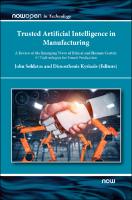Trusted Artificial Intelligence in Manufacturing; Trusted Artificial Intelligence in Manufacturing
A Review of the Emerging Wave of Ethical and Human Centric AI Technologies for Smart Production; A Review of the Emerging Wave of Ethical and Human Centric AI Technologies for Smart Production
Contributor(s)
Soldatos, John (editor)
Kyriazis, Dimosthenis (editor)
Language
EnglishAbstract
The successful deployment of AI solutions in manufacturing environments hinges on their security, safety and reliability which becomes more challenging in settings where multiple AI systems (e.g., industrial robots, robotic cells, Deep Neural Networks (DNNs)) interact as atomic systems and with humans. To guarantee the safe and reliable operation of AI systems in the shopfloor, there is a need to address many challenges in the scope of complex, heterogeneous, dynamic and unpredictable environments. Specifically, data reliability, human machine interaction, security, transparency and explainability challenges need to be addressed at the same time. Recent advances in AI research (e.g., in deep neural networks security and explainable AI (XAI) systems), coupled with novel research outcomes in the formal specification and verification of AI systems provide a sound basis for safe and reliable AI deployments in production lines. Moreover, the legal and regulatory dimension of safe and reliable AI solutions in production lines must be considered as well. To address some of the above listed challenges, fifteen European Organizations collaborate in the scope of the STAR project, a research initiative funded by the European Commission in the scope of its H2020 program (Grant Agreement Number: 956573). STAR researches, develops, and validates novel technologies that enable AI systems to acquire knowledge in order to take timely and safe decisions in dynamic and unpredictable environments. Moreover, the project researches and delivers approaches that enable AI systems to confront sophisticated adversaries and to remain robust against security attacks. This book is co-authored by the STAR consortium members and provides a review of technologies, techniques and systems for trusted, ethical, and secure AI in manufacturing. The different chapters of the book cover systems and technologies for industrial data reliability, responsible and transparent artificial intelligence systems, human centered manufacturing systems such as human-centred digital twins, cyber-defence in AI systems, simulated reality systems, human robot collaboration systems, as well as automated mobile robots for manufacturing environments. A variety of cutting-edge AI technologies are employed by these systems including deep neural networks, reinforcement learning systems, and explainable artificial intelligence systems. Furthermore, relevant standards and applicable regulations are discussed. Beyond reviewing state of the art standards and technologies, the book illustrates how the STAR research goes beyond the state of the art, towards enabling and showcasing human-centred technologies in production lines. Emphasis is put on dynamic human in the loop scenarios, where ethical, transparent, and trusted AI systems co-exist with human workers. The book is made available as an open access publication, which could make it broadly and freely available to the AI and smart manufacturing communities.
Keywords
Artificial Intelligence, Trusted AI, Explainable AI, AI Security, Data Reliability, Ethical AIDOI
10.1561/9781680838770ISBN
9781680838770, 9781680838763, 9781680838770Publisher
Now PublishersPublication date and place
Norwell, 2021Imprint
Now PublishersSeries
NowOpen,Classification
Artificial intelligence


 Download
Download